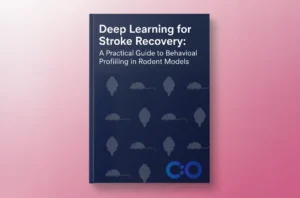

In the rapidly advancing field of behavioral neuroscience, the ability to train machine learning models on one species and adapt them to another represents a powerful opportunity to streamline experimental workflows, reduce labeling effort, and enhance cross-species comparisons. This strategy—known as cross-species transfer learning—has gained traction as a way to extend the utility of pose estimation, behavior classification, and neural decoding models originally trained on mice to other laboratory organisms such as rats, zebrafish, and even non-rodent species.
This article explores the conceptual underpinnings and practical methodologies behind transfer learning in ethological research. It details how to manage differences in morphology, camera geometries, and behavioral repertoires using techniques like domain adaptation, fine-tuning and benchmarking. We also examine how modular platforms from Conduct Science support scalable cross-species behavioral research.
Training deep learning models from scratch for every species, setup, or behavior type is prohibitively time- and labor-intensive. Transfer learning mitigates this cost by leveraging knowledge from source datasets (typically well-annotated mouse datasets) to accelerate model performance on target species. The scientific advantages include
This is especially relevant for multi-species platforms—such as those offered by Conduct Science—where researchers may transition between rodent models and aquatic organisms like zebrafish for developmental or pharmacological studies.
Cross-species transfer learning offers significant promise, but it also presents complex technical and biological challenges. Transferring models trained on one species (such as mice) to others (like rats or zebrafish) requires overcoming differences not only in anatomy and movement but also in experimental setups and behavioral semantics. These differences can severely impair model generalization if not carefully addressed. Below, we explore the core obstacles that researchers must navigate to achieve effective transfer learning in behavioral neuroscience.
One of the most fundamental challenges in cross-species transfer is the variation in body plans and movement dynamics between species.
These differences necessitate adaptable models that can learn species-invariant movement features while still respecting species-specific nuances.
Transfer learning also suffers from inconsistencies in camera placement, lens type, resolution, and arena configuration.
These variations demand robust preprocessing and architecture design that can disentangle geometry-dependent features from behaviorally relevant ones.
Another underappreciated challenge is the semantic mismatch in behavioral annotations across species.
Such inconsistencies impair supervised behavior classifiers and call for unsupervised motif discovery, allowing behaviors to be defined from the data itself rather than imposed a priori.
Deep learning models are highly expressive but also prone to overfitting—especially when trained on richly annotated but homogenous datasets.
Without intentional regularization and domain adaptation strategies, these models can carry forward narrow biases that reduce their cross-species applicability.
Finally, there is a significant lack of standardized cross-species benchmarks in behavioral neuroscience.
This absence of standardized evaluation pipelines complicates benchmarking and hinders the development of generalizable, species-agnostic behavioral models.
Conduct Science provides researchers with experimental tools that mitigate many of these challenges:
To fully realize the promise of cross-species transfer learning, researchers must combine thoughtful experiment design with rigorous algorithm development—ensuring that the complexity of biological diversity is met with equally adaptable computational tools.
Domain adaptation aims to align the feature spaces of source and target domains—e.g., mouse and rat video frames—without requiring full retraining.
This approach is particularly useful when using shared behavioral analysis platforms across species, such as those described in Conduct Science’s arena design solutions, which standardize lighting and camera angles for cross-lab consistency.
Instead of building a new model, fine-tuning involves updating a pre-trained model on a small labeled subset of the new species data.
Fine-tuning provides a balance between performance and efficiency, making it ideal for labs working across multiple species with limited annotation capacity.
To assess how well a transferred model performs:
Benchmarking across species also enables comparative studies—e.g., whether the same motif classifier detects “chase” in mice and rats with equivalent accuracy—thereby strengthening the ethological relevance of your research.
The expansion of behavioral neuroscience into multi-species domains has elevated zebrafish from a developmental biology model to a core organism in translational neuroscience. Their genetic tractability, high-throughput potential, and transparent embryonic development make them ideal for drug discovery and neurobehavioral screening. However, adapting machine learning tools trained on terrestrial rodents to aquatic species like zebrafish presents unique conceptual and technical hurdles—and fascinating opportunities.
By applying cross-species transfer learning, researchers can extend models developed for rodents to zebrafish, generating shared representations of behavior across distinct locomotor systems and body morphologies. This adaptation supports the construction of generalizable behavioral pipelines, enabling comparative studies that bridge evolutionary distance and diversify experimental insights.
Zebrafish locomotion is driven by undulatory tail movements and coordinated fin adjustments, producing fluid-based propulsion rather than limb-based walking or running. This key distinction necessitates tailored adaptations in pose estimation and behavior modeling:
Despite these differences, certain behavioral archetypes are evolutionarily conserved, such as avoidance responses, exploration, group cohesion, and stimulus-driven approach or escape. These afford a foundation for cross-species behavior mapping using adapted models.
To transfer rodent-trained pose estimation models to zebrafish, several key modifications are required:
While rodents express behaviors like chasing, rearing, or huddling, zebrafish display species-specific analogs:
By training classifiers on functional, rather than morphological, behavior categories (e.g., “approach,” “withdrawal,” “freezing”), researchers can create cross-species behavioral taxonomies that facilitate comparative neuroscience.
Zebrafish offer powerful experimental advantages for studies where large-scale screening is essential. Cross-species transfer learning enhances the utility of these models in:
Platforms from Conduct Science support these workflows with customized aquatic arenas, top-view tracking systems, and compatibility with high-throughput video analysis tools—ideal for labs working across both terrestrial and aquatic domains.
The ultimate goal of transferring models from rodents to zebrafish is to establish shared behavioral ontologies—data-driven frameworks that define behaviors not by species-specific labels, but by underlying kinematic and social patterns.
For example:
With continued refinement, such mappings could enable
As the scope of behavioral neuroscience expands to include multiple species, environments, and behavioral paradigms, the need for modular, adaptable, and scalable research infrastructure becomes paramount. Conduct Science has responded to this demand by offering a comprehensive suite of tools designed to facilitate multi-species behavioral analysis, from rodents to zebrafish and beyond. These tools are specifically engineered to support advanced tracking, pose estimation, and experimental reproducibility across a variety of research contexts.
Conduct Science provides customizable arena systems tailored for different species and behavioral assays.
Each arena can be easily incorporated into pose estimation workflows using DeepLabCut, SLEAP, or custom neural network pipelines—making them ideal for researchers employing transfer learning or working with multi-species datasets.
Cross-species behavioral studies often require multi-angle and high-resolution video capture, particularly when comparing species with different locomotor dynamics or when monitoring social interactions in three dimensions.
Conduct Science supports this need with:
These configurations are essential for reducing occlusion, improving pose accuracy, and enabling 3D reconstruction of behavior—particularly useful when comparing rodents’ limb-driven locomotion to zebrafish’s wave-like swimming patterns.
Lighting conditions and visual contrast dramatically impact the performance of pose estimation models and transfer learning accuracy. Conduct Science ensures consistency and reproducibility through:
These features reduce visual variability, which is critical when applying models across different labs, species, and behavioral tasks.
Whether researchers are performing pose estimation, motif discovery, or cross-species behavior classification, Conduct Science tools are designed to integrate with AI-based platforms such as
With standardized spatial dimensions, calibrated video outputs, and stable environmental variables, Conduct Science systems simplify domain adaptation and fine-tuning, both essential for effective transfer learning.
A major strength of Conduct Science platforms is their custom-built flexibility. Researchers can tailor arena dimensions, wall configurations, and sensor integration (e.g., motion detectors, RFID tracking, or stimulus delivery systems) according to their unique experimental goals—whether working with social rodents or free-swimming fish.
Moreover, the modular design ensures that experiments conducted across different institutions can be standardized and replicated, a key factor in comparative and collaborative neuroscience.
Conduct Science’s offerings are not limited to arenas and cameras—they extend to a full experimental pipeline:
This holistic design ensures that researchers can seamlessly integrate behavior, neural data, and computational analysis within a single experimental ecosystem.
Conduct Science enables multi-species behavioral research by providing:
These tools lay the groundwork for the next generation of behavioral research—one that is flexible, scalable, and scientifically rigorous. Whether developing cross-species models of social behavior, transferring pose estimators from rodents to fish, or benchmarking the effects of pharmacological treatments across vertebrates, Conduct Science equips researchers with the infrastructure to make high-impact discoveries across species boundaries.
Explore modular setups at ConductScience.com and detailed walkthroughs on the Conduct Science YouTube Channel, where video-based behavior tracking is applied to diverse experimental models.
As behavioral neuroscience continues to embrace high-throughput technologies, unsupervised learning, and cross-species frameworks, the field is approaching a pivotal transformation: the development of universal behavioral models. These models aim to generalize across species, contexts, and environments—recognizing not just species-specific actions but core movement patterns and functional behaviors that transcend anatomical and ecological differences. Achieving this vision requires a convergence of computational innovation, standardized experimental platforms, and cross-disciplinary collaboration.
Current behavior classification pipelines are often trained for one species, in one experimental setup, using one behavioral taxonomy. As a result, models trained on laboratory mice may fail when applied to rats, zebrafish, or other species, even if the core behavior—such as exploration, threat response, or social approach—is functionally similar.
A universal behavioral model would enable
This would transform how researchers build models of brain function, especially in areas such as emotion, social behavior, motivation, and decision-making.
To move toward universality, several foundational principles must guide model design:
To support these goals, universal behavioral modeling will leverage:
Conduct Science’s modular arenas and multi-species tracking systems are well-suited to generate this kind of structured, comparable data—supporting efforts to train and validate generalizable models.
Universal behavioral models would unlock a host of new capabilities in neuroscience and beyond:
The path to universal behavioral models will require collaborative infrastructure:
As more labs adopt multi-species experimental designs and align around shared computational tools, the foundation for universal behavior modeling will solidify—offering a future in which behavioral insights are not bound by species but unified by function and structure.
Mathis, A., & Mathis, M. W. (2020). Deep learning tools for the measurement of animal behavior in neuroscience. Current Opinion in Neurobiology, 60, 1–11. https://doi.org/10.1016/j.conb.2019.10.008
Pereira, T. D., Shaevitz, J. W., & Murthy, M. (2020). Quantifying behavior to understand the brain. Nature Neuroscience, 23(12), 1537–1549. https://doi.org/10.1038/s41593-020-00734-x
Berman, G. J. (2018). Measuring behavior across scales. BMC Biology, 16(1), 23. https://doi.org/10.1186/s12915-018-0494-7
Wiltschko, A. B., et al. (2015). Mapping sub-second structure in mouse behavior. Neuron, 88(6), 1121–1135. https://doi.org/10.1016/j.neuron.2015.11.031
Datta, S. R., et al. (2020). The science of behavior: integrating movement and brain activity in freely behaving animals. Nature Neuroscience, 23(12), 1522–1531. https://doi.org/10.1038/s41593-020-00703-4
Graving, J. M., et al. (2019). DeepPoseKit, a software toolkit for fast and robust animal pose estimation using deep learning. eLife, 8, e47994. https://doi.org/10.7554/eLife.47994
Conduct Science. (n.d.). Behavioral Neuroscience Tools & Modular Arena Systems. Retrieved from https://conductscience.com/behavior/behavior-analysis/Conduct Science YouTube Channel. (n.d.). Equipment Walkthroughs and Experimental Setups. Retrieved from https://www.youtube.com/@conductscience
